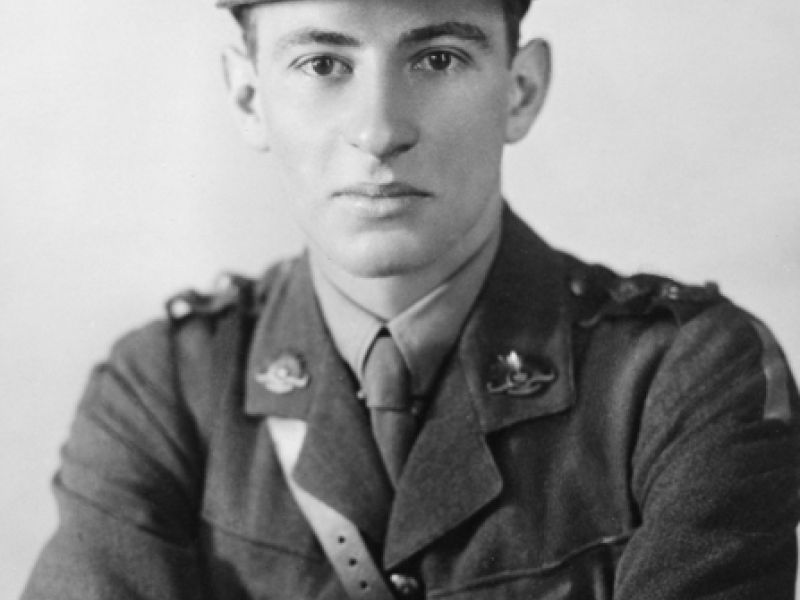38 Lieutenant Wilfrid Oswald Jose, 50th Battalion, AIF KIA: 3 April 1917
Wilfrid Jose was born on 25 March 1895 in Ningpo, China, the second of three sons born to the Reverend George Jose and his wife Clara. Wilfred spent the first eight years of his life in China while his father did missionary work.
The Jose family migrated to Adelaide in 1903, where Reverend George Jose took up the ministry of St Cyprian’s before becoming rector of Christ Church in 1906.
Wilfred attended St Peters College and was a gifted student. He achieved honours in all of his examinations and was awarded a raft of scholarships. In 1912 he became school prefect and was dux of the school. He was also a member of the school cadets and rose to the rank of lieutenant.
In 1913 he was made school captain and head prefect. He was vice-captain of the school’s cricket, tennis and football teams. In a final honour, he was declared Young Exhibitioner of St Peters College, having been named the best performing student of the year.
The following year he began an engineering degree at Adelaide University. He also continued to pursue his sports interests and began serving with the 79th Infantry Regiment.
His studies were interrupted by the outbreak of the First World War. He was among the first to join the newly-raised 10th Battalion at Morphettville on 19 August. He was given the service number 38 and allocated to A Company.
Jose soon found himself serving in the battalion’s scout platoon along with several former St Peters College students including Arthur Blackburn, Tom Whyte, John Gordon and Phil Robin, a champion Australian Rules player for the Norwood Football Club. At the age of 19, Jose was the youngest member of the platoon. During training he acquired the nickname “Dill”.
After the battalion had completed its initial training, Jose and his comrades embarked from Outer Harbour, Adelaide aboard the transport ship Ascanius initially bound for England. Following a brief halt at Fremantle, the ship sailed in convoy with other transport ships to Colombo. There was a bit of a stir on the next leg of the journey when Ascanius collided with the transport Shropshire, damaging both vessels. However, the damage was not too significant and both ships made the next port at Aden.
By this time the Australians had been directed to disembark at Cairo due to the poor conditions on Salisbury Plain in England. The Australians instead established their camp at Mena and continued training for war in the desert.
In early March, the 10th Battalion sailed for Lemnos Island in preparation for the Gallipoli campaign. The men then travelled on the transport ship Ionian which the men soon re-christened One Onion.
In the early hours of 25 April, Jose was among the first men of the 10th Battalion to step ashore on Gallipoli. After the AIF had established a foothold on Gallipoli, the 10th Battalion occupied positions at Silt Spur, near Lone Pine. It would remain in these positions for most of the campaign.
Due to poor sanitation and lack of fresh food and water, Jose was evacuated to Lemnos in late August with dysentery. He recovered quickly and was soon back with the battalion. He was promoted to temporary corporal in September.
The 10th Battalion’s Gallipoli campaign came to an end in mid-November when it was withdrawn to Lemnos. The same month Jose was hospitalised with jaundice, but he was well enough to travel with the battalion when it returned to Egypt at the end of December.
In January and February 1916 the AIF took on new recruits and almost doubled in size, expanding from two to five divisions in the process. The 10th Battalion provided an experienced cadre of men to help form the 50th Battalion. Jose, now a corporal, was selected to transfer to the new battalion.
After joining the 50th Battalion in late February, he was commissioned with the rank of second lieutenant. The battalion sailed for France in June and entered the front line for the first time at Fleurbaix at the end of the month. The battalion spent the next two weeks in the line. Jose was promoted to lieutenant on the 10th of July and the following day the battalion was relieved and sent south to the Somme.
In late July, Jose was evacuated with severe conjunctivitis and sent to England to recover. He was not able to rejoin his unit until December and managed to arrive in France in the middle of the worst recorded winter in decades. The battalion spent the winter rotating in and out of the front line.
In February 1917 the Germans withdrew to the Hindenburg Line. To delay the Allied forces following their retreat, the Germans had fortified a number of villages on the approach to the Hindenburg Line.
On 2 April 1917 the 50th Battalion participated in an attack on the village of Noreuil. A Company, of which Jose was a platoon commander, moved around to the right of the attack in order to support the rest of the battalion as it hooked through the village.
A Company encountered unbroken barbed wire defences which took some time to get through. Near the south-west corner of the village the Australians came under enfilading fire from a platoon of Germans with a machine-gun who were protected by a barricade, a steep bank and barbed wire. The machine-gun took a heavy toll of the Australians and within a short space three of the platoon commanders had been killed or mortally wounded. Among the dead was Wilfred Jose.
The attack continued, and during further bitter fighting, a number of men from A Company were captured. Thrown into disarray, the company struggled to advance, eventually establishing a position within 100 yards of their objective.
Although initially listed as missing in action, Jose’s body was recovered and laid to rest in the Noreuil Australian Cemetery. He was 22 years old.

 Australian War Memorial
Australian War Memorial